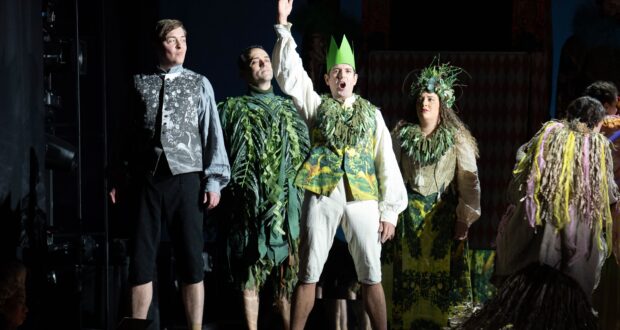Thankfully, no clear bedrock of an idea or concept onstage can ever stop the excellent music cutting through.Summary
Rating
OK
Stravinsky’s 1951 work is loosely based on the eight satirical paintings by Hogarth, which the composer had an opportunity to view at the 1947 Chicago Exhibition. WH Auden and Chester Kallman wrote the libretto, often considered the best in English.
The music spans immense, bright and awesome moods as well as the playful and silly. Stravinsky’s score is a wonderful way of telling the story of Tom Rakewell, the wastrel heir to a great fortune endowed with many hereditary privileges – self-restraint not one of them. Egged on by mysterious handler Shadow, he moves to London, disowns his provincial fiancée, marries a bearded woman, make a poor investment in a bread machine and ends up penniless and potty. It’s a pretty easy concept but not a clear story in this baffling new staging.
Set, staging, lighting, movement director and illusion director all want a stir of the pot in this unfocussed production. Polly Graham has directed the show as a very busy affair; lots of offing and onning of chorus with no conceivable purpose or reason. Movement is frequently a substitute for character development and a barrier to taking in what’s actually happening. The lighting often can’t find a mood, which hardly helps a confused audience. For what it’s worth, it’s not clear what the movement and illusion directors were on the payroll for.
On opening night the lead, Frederick Jones is sick but admirably chooses to walk the part, with Brenton Spiteri singing his role (and very, very well). The singing is fantastic, but in all roles bar one a sense of character is lacking. Lauren Young as Baba the bearded lady is excellent. Despite being given very little to do, she has the audience eating out of the palm of her hand.
The one constant throughout the action, designer April Dalton’s mirrored and slanted stage, is set with maypoles, chairs or horses on wheels as appropriate. The maximalist style is appropriate for the story, but as it is presented here, it is dated and cheap. It’s probably worth a trigger warning for the blinding you get at the end of act three when all of the light bounces off the set. Designer and lights in an amateur misstep.
ETO are touring a small but mighty band. Conductor Jack Sheen, one to be watched, has clearly worked very hard on this score. Every sound is bright, despite the scaling down. I’ve never heard this orchestra sound so good – they could give the larger forces of the ENO a run for their money. Thankfully, no clear bedrock of an idea or concept onstage can ever stop the excellent music cutting through.
Composer: Igor Stravinsky
Director: Polly Graham
Conductor: Jack Sheen
Designer: April Dalton
Lighting Designer: Ben Ormerod
Movement Director: Alex Gotch
The Rake’s Progress continues on tour until 28 May. Further details and booking can be found here.
 Everything Theatre Reviews, interviews and news for theatre lovers, London and beyond
Everything Theatre Reviews, interviews and news for theatre lovers, London and beyond



